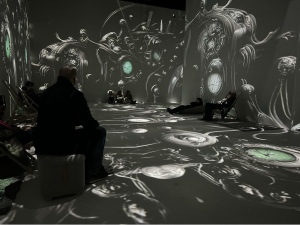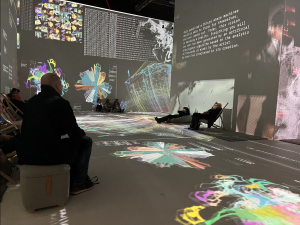
Salvador Dalí predicted a future where machines would be able to think for themselves.
The Art Law module has gone from strength to strength again this academic year, providing a unique illustration of our Department’s highly distinctive, innovative teaching practice, with a strong emphasis on cross-disciplinarity and immersive legal education.
Led by Dr Plamen Dinev, whose research expertise spans a broad range of specialist areas, including intellectual property, technology (particularly 3D printing) and arts, the module brings together Goldsmiths Law faculty and a range of external partners and contributors.
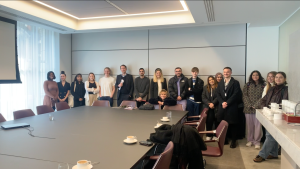
Mishcon de Reya are co-teaching our Art Law module, with one of the lectures taking place in their 21st century boutique law firm offices.
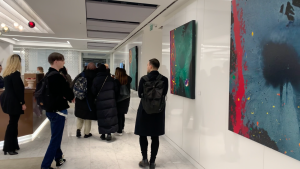
Part lecture, part exhibition.
We are especially thankful to Mishcon de Reya, a globally leading law firm specialising in the interconnections between law, technology and the arts, for co-teaching the module from their London office. The Art Law class visited Mishcon’s offices, for a two-hour lecture on the Art Market (and how Law regulates it), which was preceded by observation and discussion around the art collection that Mishcon house in their offices. The collection featured a range of powerful images taken by American photojournalist Eve Arnold – the first woman to join Magnum Photos – known for documenting Malcolm X and the Black Power movement in the United States.
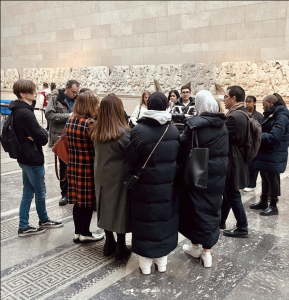
A mini lecture from within the Parthenon marbles gallery at the British Museum. Prof Giannoulopoulos addresses their cultural and historic significance for Greece.
Earlier in the term, the Art Law students had a class in the British Museum, from within the Parthenon marbles gallery, with the conversation revolving around Greece’s claim for the repatriation of the marbles and their return to the Acropolis museum in Athens; Ioannis Andritsopoulos, the UK correspondent of Greece’s leading daily “Ta Nea”, whose investigative journalism has brought to the surface Boris Johnson’s Oxford Union speech which was making a passionate case for repatriation, and who has more recently revealed that the British museum is in ‘preliminary’ talks with Greece around finding a formula for the return of the marbles, spoke to the students about his work in this area. In the conversation that followed, this time at the Royal Society of Arts, where the group moved after the visit to the British Museum, the students drew on colonialist critiques and ideas of cultural heritage to show, predominantly, feelings of empathy with the claim for the return of the marbles. They also partook in a debating exercise where they had to argue for and against repatriation.
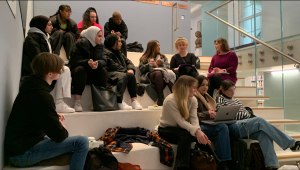
Goldsmiths Law students at the Royal Society of Arts, after their visit to the British Museum, debating ‘for” and “against” the repatriation of the Parthenon marbles.
In the penultimate week of term, the Art Law class was in central London again, this time visiting the wonderful Courtauld gallery, in the morning, where they were given a tour of works of Van Gogh, Gauguin, Monet, Cézanne, Manet, before visiting the Morgan Stanley exhibition on Peter Doig, one of the most celebrated and important painters working today, whose work has been heavily influenced from these major impressionist and post-impressionist artists housed in the Courtauld. Tanya Harris, from the Courtauld, contextualised the paintings for the students, confronting them with questions surrounding gender-equality, class division, and racial justice. Jonathan Bridges, formerly at Goldsmiths, and now at the Courtauld, had made the visit possible for our students.
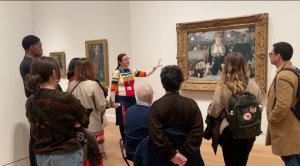
Discussing Édouard Manet’s “A Bar at the Folies Bergère”
“Part of the exhibition and tour allowed us to see how Peter Doig ‘takes inspiration from art, music, poetry and film’, and how ‘his paintings are often rooted in the experience of places and people, or spring from a photograph or a captivating image in a book’”, noted Professor Dimitrios Giannoulopoulos, the Head of the Department, who helped introduce, with Dr Dinev, some of the key external activities in the Art Law curriculum, and who attended the visit. “Our approach to deconstructing Law at Goldsmiths is equally multi-dimensional and immersive”, Dimitrios highlighted for the attention of some of the students attending, calling upon them to “use art, music, film, poetry”, and to “interact with places and people”, in their effort to analyse the Law.
He also added: “The world-renowned comparative law scholar, Prof Mireille Delmas-Marty, first of the Sorbonne and then of the Collège de France, would always bring poetry into her lectures, to depict complex movements, transitions, transformations, divergence and rapprochement, in Law and society. I have more recently seen our Visiting Professor, Leslie Thomas KC, do the same thing, with great impact, in his anti-racist criminal law lectures, at Gresham College and Goldsmiths, and in all the other places where audiences were fortunate enough to see how deeply Law can be enriched in this way, and that breaking long-standing cultural barriers may require the emotional power that one can find in poetry, literature and music (much more than in black letter law).”
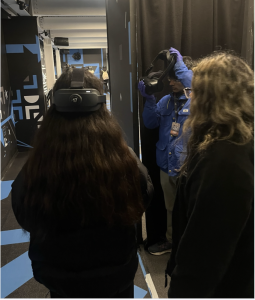
Students exploring Dali with the help of VR technology
After the visit to the Courtauld, the students engaged with a highly immersive visit to the Dali: Cybernetics – The Immersive Experience. Using state-of-the-art audiovisual media, the exhibition exposed our students to surrealist Salvador Dalí, whose dreamlike works have had a profound influence on such modern artists as Jeff Koons and Goldsmiths graduate Damien Hirst. The installation included an interactive virtual reality journey into Dalí’s most iconic paintings, featuring oneiric scenes inspired by the work of psychoanalyst Sigmund Freud.
“From Dalí to DALLE-E 2 – as part of modules such as Art Law and AI Law, our students have had the opportunity to place the law within its socio-economic context and explore the legal implications of artificial intelligence, VR, and other cutting-edge technologies currently shaping the modern art world”, commented Dr Plamen Dinev, module convenor for Art Law.
